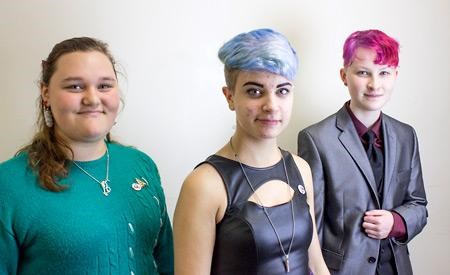Powell River board of education trustees are being asked to consider strengthening School District 47’s policy on intolerance.
Brooks Secondary School’s Gay, Straight, Transgender Alliance (GSTA) club and its teacher sponsors were the newly elected board’s first delegation at December’s public meeting, the first to be held since October.
The club has asked the board to consider joining the majority of BC school districts by drafting an anti-homophobia and anti-transphobia policy, something that would augment the school district’s already existing policy around unacceptable conduct. The current policy prohibits discrimination on the basis of sexual orientation or gender expression.
The club has been operating at Brooks since 2009 and Tony Marciniak, a counsellor at the high school, has been the group’s main teacher sponsor for the past two years. He and Allison Burt, another counsellor at the school, have worked together to facilitate the group since its inception.
“What we are is a voice for students who are gay or straight,” said Marciniak, adding that the club serves as support group for those who have come out and also those who have not yet.
It provides opportunities for students to meet others, learn more about homophobia and transphobia, and offers them a chance to educate others about issues relating to sexual orientation.
“And it’s a group just to plan fun activities too,” said Burt. During the first few years of the club, its main focus was on social activities for members. “It’s not all about political awareness.”
But even after five years of being in the school, there is a long way to go, said Oliver Murphy, the club’s organizer since 2012.
“It’s still invisible to most of the school,” he said adding that while a big part of what the club hopes to achieve is increased awareness, another important piece is creating a warmer climate in the school for students who are gay or transgender.
There are about 10 students in the club.
One of the group’s education campaigns is to create anti-homophobia posters for each classroom, said Marciniak.
“We’re trying to build up a climate of trust, so students feel like they can be who they truly are.” The posters will help motivate people who are concerned by the insensitivity of others to continue to stand up and impose higher community standards, something key toward changing attitudes, he said.
Teresa Coe, another member of the club, also a presenter to the board of education, said, “It’s such a good club because it provides us with a sense of family. Everyone who goes there feels comfortable, it’s great.”
But that is certainly not the case for the majority of LGBT (lesbian, gay, bisexual, transgender) students in Canada’s schools. In a 2011 survey EGALE Canada, an equality for LGBT advocacy organization, found that almost two thirds of LGBT students and more than 60 per cent of those with LGBT parents reported they felt unsafe at school.
The study revealed a large majority of students, both straight and LGBT, heard homophobic expressions throughout the school day. And that 74 per cent of transgender students, 55 per cent of students of sexual minorities and 26 per cent of straight students reported having been verbally harassed about their sexual orientation or gender expression.
“A lot of students don’t want to hear the kinds of words that are thrown around flippantly,” Burt said, explaining that despite progress being made, more work needs to be done.
She said the emotional trauma that bullied and harassed students have manifests itself though increased rates of mental health issues, drug and alcohol abuse, absenteeism, dropping out from school and suicide.
In schools with specific anti-homophobia policies, 80 per cent of LGBT students reported never being harassed, compared to 67 per cent in schools without the policy, Burt added.
Given that, the club is hoping for the board to toughen up its policies around homophobia.
They believe, with the increased awareness around homophobia and raised empathy for students with differences, the policy will not only improve the lives of LGBT students, but also facilitate a more accepting, welcoming milieu with less violence, racism and sexism at the school.



